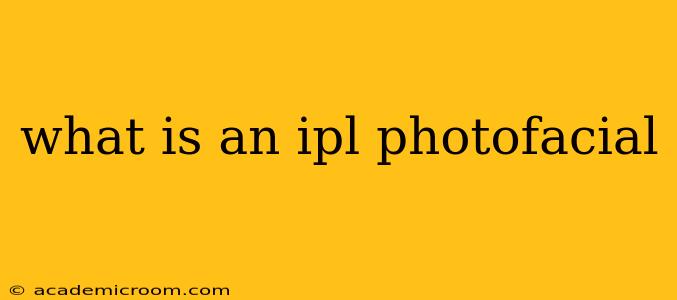Intense pulsed light (IPL) photofacials are a popular non-invasive cosmetic procedure used to improve the appearance of the skin. They offer a multifaceted approach to skin rejuvenation, addressing a range of concerns simultaneously. But what exactly is an IPL photofacial? This comprehensive guide will delve into the details, answering common questions and helping you understand if it's the right treatment for you.
What are the benefits of IPL photofacial?
IPL photofacials offer a multitude of benefits, making them a versatile option for various skin concerns. These include:
- Reducing the appearance of sunspots and age spots: IPL targets melanin, the pigment responsible for these discolorations, effectively lightening them.
- Improving skin texture and tone: The treatment stimulates collagen production, leading to firmer, smoother skin with a more even tone.
- Minimizing the appearance of redness and broken capillaries: IPL's heat energy targets blood vessels, reducing their visibility and improving the overall complexion.
- Treating acne and acne scars: The light energy can kill acne-causing bacteria and reduce inflammation, leading to clearer skin and less noticeable scarring.
- Reducing pore size: By stimulating collagen production, IPL can help tighten pores, leading to a refined skin texture.
How does IPL photofacial work?
IPL photofacials utilize intense pulsed light, a broad spectrum of light energy that targets various chromophores (light-absorbing molecules) in the skin. The light energy is converted into heat, which causes the targeted areas to gently heat up. This heat triggers a cascade of beneficial effects:
- Melanin destruction: The heat energy breaks down melanin, reducing the appearance of sunspots and age spots.
- Collagen stimulation: The heat stimulates fibroblast cells, increasing collagen and elastin production, leading to skin tightening and improved texture.
- Blood vessel closure: The heat energy seals off broken capillaries, reducing redness and improving overall skin tone.
What are the side effects of IPL photofacial?
While generally safe, IPL photofacials can have some mild side effects, most of which are temporary:
- Redness and swelling: This is common and usually subsides within a few hours or days.
- Slight bruising: This is less common but possible, especially in areas with more delicate skin.
- Crusting or scabbing: This can occur in treated areas and typically falls off within a week.
- Changes in skin pigmentation: In rare cases, hyperpigmentation (darkening) or hypopigmentation (lightening) can occur.
How many IPL photofacial treatments are needed?
The number of treatments required varies depending on individual needs and the severity of the skin condition being treated. Most people require a series of 3-6 treatments, spaced several weeks apart, to achieve optimal results.
Is IPL photofacial painful?
Most patients describe the sensation during an IPL photofacial as a mild snapping or tingling feeling. A cooling gel is typically applied before the treatment to minimize discomfort.
What is the recovery time for IPL photofacial?
Recovery time is generally minimal. Most people can return to their normal activities immediately after the treatment. However, it's advisable to avoid sun exposure and use sunscreen with a high SPF for several days following the treatment.
How much does IPL photofacial cost?
The cost of an IPL photofacial varies depending on location, the number of treatments needed, and the size of the area being treated. It's best to consult with a qualified dermatologist or medical spa to get a personalized price quote.
What is the difference between IPL and laser treatments?
While both IPL and laser treatments use light energy to improve skin appearance, there are key differences:
- Wavelength: Lasers use a single wavelength of light, while IPL uses a broad spectrum of wavelengths.
- Target: Lasers are more precise in targeting specific areas, while IPL is a more generalized treatment affecting multiple skin concerns at once.
- Applications: While both can treat many similar conditions, laser treatments are often better suited for specific conditions like hair removal or very specific vascular lesions.
This information is intended for educational purposes only and should not be considered medical advice. Always consult with a qualified dermatologist or medical professional before undergoing any cosmetic procedure. They can assess your individual skin condition and determine if an IPL photofacial is the right treatment option for you.
